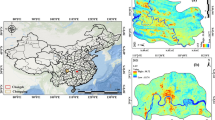Abstract
Mesoscale convective systems (MCSs) are severe disaster-producing weather systems. Radar data and infrared satellite image are useful tools in MCS surveillance. The previous method of MCS census is to look through the printed infrared imagery manually. This method is not only subjective and inaccurate, but also inefficient. Different from previous studies, a new automatic MCS identification (AMI) method, which overcomes the above disadvantages, is used in the present study. The AMI method takes three steps: searching potential MCS profiles, tracking the MCS, and assessing the MCS, so as to capture MCSs from infrared satellite images. Finally, 47468 MCSs are identified over Asia and the western Pacific region during the warm seasons (May–October) from 1995 to 2008.
From this database, the geographical distribution and diurnal variation of MCSs are analyzed. The results show that different types of MCSs have similar geographical distributions. Latitude is the main control factor for MCS distribution. MCSs are most frequent over the central Tibetan Plateau; meanwhile, this area also has the highest hail frequency according to previous studies. Further, it is found that the diurnal variation of MCSs has little to do with MCSs’ size or shape; MCSs in different areas have their own particular diurnal variation patterns. Based on the diurnal variation characteristics, MCSs are classified into four categories: the whole-day occurring MCSs in low latitude, the whole-day occurring MCSs in high latitude, the nocturnal MCSs, and the postmeridian MCSs. MCSs over most places of mainland China are postmeridian; but MCSs over the Sichuan basin and its vicinity are nocturnal. This conclusion is coincidental with the hail climatology of China.
Similar content being viewed by others
References
Anderson, C. J., and R. W. Arritt, 1998: Mesoscale convective complexes and persistent elongated convective systems over the United States during 1992 and 1993. Mon. Wea. Rev., 126(3), 578–599.
Augustine, J. A., and K. W. Howard, 1988: Mesoscale convective complexes over the United States during 1985. Mon. Wea. Rev., 116(3), 685–701.
1 —, and —, 1991: Mesoscale convective complexes over the United States during 1986 and 1987. Mon. Wea. Rev., 119(7), 1575–1
Fritsch, J. M., R. J. Kane, and C. R. Chelius, 1986: The contribution of mesoscale convective weather systems to the warm-season precipitation in the United States. J. Climate Appl. Meteor., 25(10), 1333–1345.
Houze, R. A. Jr., B. F. Smull, and P. Dodge, 1990: Mesoscale organization of springtime rainstorms in Oklahoma. Mon. Wea. Rev., 118(3), 613–654.
Jirak, I. L., W. R. Cotton, and R. L. Mcanelly, 2003: Satellite and radar survey of mesoscale convective system development. Mon. Wea. Rev., 131(10), 2428–2449.
Laing, A. G., and J. M. Fritsch, 1993a: Mesoscale convective complexes over the Indian monsoon region. J. Climate, 6(5), 911–919.
1 —, and —, 1993b: Mesoscale convective complexes in Africa. Mon. Wea. Rev., 121(8), 2254–
Lu Xinyan and Duan Yihong, 2011: Characteristics of the tropical cyclogenesis in the summer monsoon trough. Acta Meteor. Sinica, 69(6), 990–1000. (in Chinese)
Ma Yu, Wang Xu, and Tao Zuyu, 1997: Geographic distribution and life cycle of mesoscale convective system in China and its vicinity. Prog. Nat. Sci., 7(6), 701–706. (in Chinese)
Maddox, R. A., 1980: Mesoscale convective complexes. Bull. Amer. Meteor. Soc., 61(11), 1374–1387.
—, D. M. Rogers, and K. W. Howard, 1982: Mesoscale convective complexes over the United States during 1981-Annual summary. Mon. Wea. Rev., 110(10), 1501–1514.
Miller, D., and J. M. Fritsch, 1991: Mesoscale convective complexes in the western Pacific region. Mon. Wea. Rev., 119(12), 2978–2992.
Parker, M. D., and R. H. Johnson, 2000: Organizational modes of midlatitude mesoscale convective systems. Mon. Wea. Rev., 128(10), 3413–3436.
Rafiuddin, M., H. Uyeda, and M. N. Islam, 2010: Characteristics of monsoon precipitation systems in and around Bangladesh. Int. J. Climatol., 30(7), 1042–1055.
Romatschke, U., and R. A. Houze Jr., 2010: Extreme summer convection in South America. J. Climate, 23(14), 3761–3791.
1 —, and —, 2011a: Characteristics of precipitating convective systems in the South Asian monsoon. J. Hydrometeor., 12(1), 3–26
2 —, and —, 2011b: Characteristics of precipitating convective systems in the premonsoon season of South Asia. J. Hydrometeor., 12(2), 157–180
—, S. Medina, and R. A. Houze Jr., 2010: Regional, seasonal, and diurnal variations of extreme convection in the South Asian region. J. Climate, 23(2), 419–439.
Roy Bhowmik, S. K., S. Sen Roy, and P. K. Kundu, 2008: Analysis of large-scale conditions associated with convection over the Indian monsoon region. Int. J. Climatol., 28(6), 797–821.
Shu Yu and Pan Yinong, 2010: Self-identification of mesoscale convective system from satellite infrared imagery. J. Nanjing Univ. (Nat. Sci.), 46(3), 337–348. (in Chinese)
1 —, —, and Wang Wei, 2012: Statistic characteristics of MCSs over Asia and western Pacific region. J. Trop. Meteor., 18(4), 457–472.
Sui, C. H., K. M. Lau, Y. N. Takayabu, et al., 1997a: Diurnal variations in tropical oceanic cumulus convection during TOGA COARE. J. Atmos. Sci., 54(5), 639–655.
—, X. F. Li, K. M. Lau, et al., 1997b: Multiscale air-sea interactions during TOGA COARE. Mon. Wea. Rev., 125(4), 448–462.
Velasco, L., and J. M. Fritsch, 1987: Mesoscale convective complexes in the Americas. J. Geophys. Res., 192(D8), 9591–9613.
Xue Yujun, Bai Aijuan, and Li Dian, 2012: Analysis and numerical simulation of diurnal variation of precipitation in Sichuan basin. Adv. Earth Sci., 27(8), 885–894. (in Chinese)
Zhang, C. X., Q. H. Zhang, and Y. Q. Wang, 2008: Climatology of hail in China: 1961–2005. J. Appl. Meteor. Climatol., 47(3), 795–804.
Zheng Yongguang, Chen Jiong, and Zhu Peijun, 2008: Distribution and diurnal variation of MCSs over China and its vicinity in summer. Chinese Sci. Bull., 53(4), 471–481. (in Chinese)
Author information
Authors and Affiliations
Corresponding author
Additional information
Supported by the National (Key) Basic Research and Development (973) Program of China (2013CB430103), National Natural Science Foundation of China (40875028), and Forecaster Special Project Funded by the Jiangsu Meteorological Bureau (2012-8).
Rights and permissions
About this article
Cite this article
Shu, Y., Pan, Y. & Wang, J. Diurnal variation of MCSs over Asia and the western Pacific Region. Acta Meteorol Sin 27, 435–445 (2013). https://doi.org/10.1007/s13351-013-0305-6
Received:
Accepted:
Published:
Issue Date:
DOI: https://doi.org/10.1007/s13351-013-0305-6




